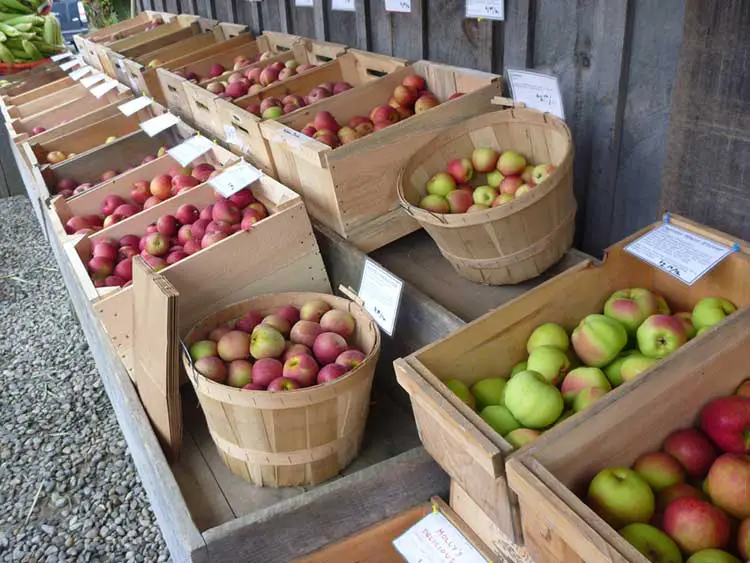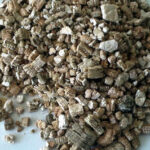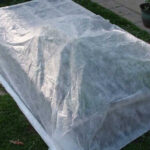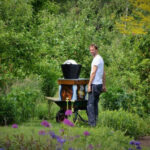It’s that time of year! The apple tree is overloaded, and you simply can’t eat them all at once. No amount of apple cobblers, apple pies, and applesauce will use them all. So it’s time for you to empty the tree and get them stored away properly, ensuring that you can enjoy this bounty for the next few months.
Whether you’re growing red or golden delicious, I’ll walk you through it all and help you figure out the best way to store apples, as well as how to pick them all.
Listen to this post on the Epic Gardening Podcast
Subscribe to the Epic Gardening Podcast on iTunes
How To Harvest Apples
Here in California where I’m at, apples season lasts from July through late November depending on the type of tree and whether it’s an early-season, mid-season, or late-season producers. I find that some of my favorite tart apples are coming ripe during the entire month of September and into October, and these are some of the best baking and cooking apples, so I definitely want to store them!
Are They Ripe?
Before you can pick your apples, you have to ensure that they’re ripe. Apples do not continue to ripen once they’re picked, so it’s important not to pick them too early. While a bug-infested or rotten apple can fall from the tree at any time, the best and usually simplest way to tell if your apples are ripe or nearly ripe is when ripe, perfect apples begin to drop on their own. Apples ripen from the outside of the tree inward, so the first ones ready will be on the very outside. Eat the outside apples, and store the inside ones quickly!
Color can also give you a hint as to whether your apples are ripe. If you’re growing a Granny Smith, and it has reached that perfect bright green hue, possibly with just a blush of yellow, you’re close. Aside from the monochrome Granny Smith and golden delicious, some of the streaked apples are a bit more difficult to gauge that way, but you can still get a good idea of if it’s almost harvest time.
Of course, the best way to test is going to require you to cut a sample apple open. Slice it in half, and then look at the seeds. If the seeds are dark brown, your apple is ripe or very nearly so. And of course, taste it! If it’s a sweet and juicy apple, or tart and tangy for the more tart varieties, you’ll know if it’s time. It should also be crisp and firm in texture.
How To Pick Apples
If you have a dwarf tree, or you’re visiting an apple orchard, this is a very simple process. Most orchards or home arborists keep their trees small so that they’re easy to pick. Reach up and grasp the apple, then roll it upwards towards its branch and give it a little twist. The apple should come off in your hand. If two apples are joined together at the stem end, you’ll likely get both with one twist.

If you’re picking from a taller tree, you may need the aid of an apple picking basket. With one of these, you can use the telescoping pole to help you reach the higher parts of the tree, and hooking the teeth of the basket over the stem will give you the ability to do a light jerk and pop the apple free from its branch. Make sure there’s a piece of foam or other padding in the bottom of the basket to prevent bruising!
A Few Picking Tips
Pick your apples early in the morning, while they’re still cool from the nighttime temperatures.
Do not wash your apples once you’ve picked them. In fact, it’s best to wash them right before they’re used. Apples have a naturally-formed protective coating while they grow on the tree, and washing that off leaves them slightly more susceptible to early spoilage.
Whichever you do, try to avoid bruising the apples. Bruised apples or a bad apple spoils more quickly. If you do bruise some, you can always make canned cinnamon apples, apple butter, or homemade canned applesauce using a water bath or pressure canner, and that will give you the ability to still eat them later. You can also try your hand at pressing cider, but that requires a bit more equipment!
How To Store Apples
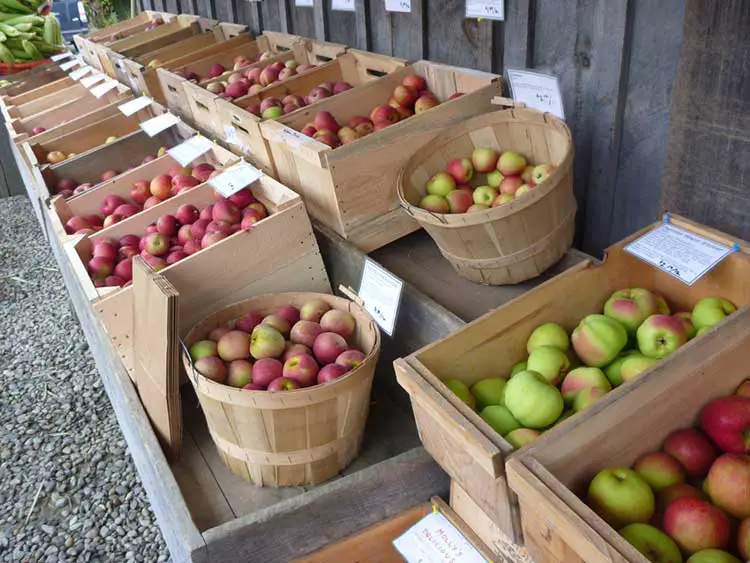
As you can see, apple picking is pretty easy. But what’s the best way to store apples? Is there a trick to how to keep apples fresh? Let’s talk about that.
How Long Do Apples Last?
Depending on the apple season in question, they will either go bad quickly, or last for months.
Early-season apples are usually meant to pick and eat right away. These are the classic snacking apples, and tend to be softer and super-juicy, easily-bruised. You may be able to store a few in your fridge for a week or two, but not much longer.
Mid-season apples are variable depending on what type of apple they are. Those which are meant as eating apples can last for a couple weeks in the fridge, and those that are meant for cooking and baking apples can be stored for up to a month and a half in the fridge. Since mid-season tends to be in the late summer, and the temperatures outside are hot, it’s harder to store these outside of the refrigerator. Even if you have a cool enough place, they don’t last as long unless kept cold.
Late-season apples are usually the apples that will last well through the winter months, both inside and outside of the refrigerator. Most of these apples can last for two to four months if stored well and kept cool. Stick with the firm-fleshed and thick-skinned varieties.
Should You Refrigerate Your Apples?
Apples will ripen 6-10 times as fast at normal room temperature as they do when kept in cold storage.
Personally, if I plan on eating the apples, I love them when they’re cold and straight out of the fridge. But should you store apples in the refrigerator normally?
The answer is: it depends. If you have an entire tree’s worth of apples, you may find that storing them all in the fridge will take the whole fridge! But if you have a box to a bushel of apples, and enough refrigerator space, it’s not a bad idea to store apples there. I personally find that a vented produce bag that allows the apples to breathe is the safest way to store them. Place 9-12 apples in a vented bag, close it, and tuck it in the crisper drawer. If you’ve got a large crisper drawer, you may be able to store 3-4 bags of apples in there.
Check them regularly to make sure they’re all in good shape and that none are starting to go soft. If you find any that are softening, have broken skins, or have bruises, remove those and use them quickly. Bruised or damaged apples will spoil first. Once one apple spoils, the others near it are at risk, so you need to go through them with regularity to make sure they’re all intact.
Preparing Your Apples For Storage
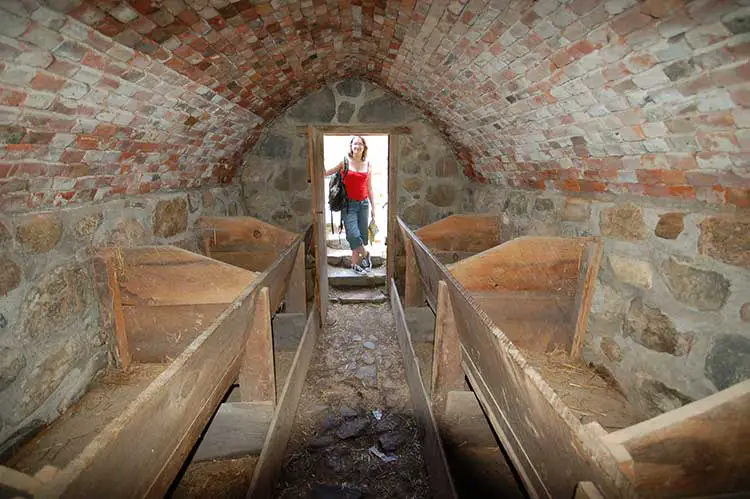 An apple storage cellar, if you’re feeling like going big on apple storage! Source
An apple storage cellar, if you’re feeling like going big on apple storage! SourceSort your apples. Larger apples tend to go bad faster than smaller apples. Store your apples by size (small/medium/large), and use your larger apples first, working your way to the smaller ones as time goes on.
Apples are interesting in that they like to have a little bit of moisture nearby so they don’t dessicate, but they don’t want constant moisture. It’s a good idea to keep a moist towel near your apples for some ambient humidity, but not on the apples. You don’t want the apples themselves to be wet.
If you are storing apples outside the refrigerator, wrap each apple individually in newspaper. The newspaper will help protect the other apples if one does spoil. A damp paper towel is also appropriate.
Once you’ve wrapped up your apples, place them in a box. You don’t want the weight of the top apples to bruise the bottom layers, so I personally try not to stack up more than two layers. I like to place a sheet of cardboard between my layers to add a little extra padding (especially if I have a leftover sheet of indented cardboard from peach season), but that’s not required.
Cardboard or wooden boxes are best for storing apples, but you can also store them in seed trays. What’s most important is that where they’re stored is cool, slightly humid, and that there’s good air circulation. Those factors will give you the best chance at long-term storage.
Store different varieties in different boxes. Just like different varieties of apples are ripe at different times, they also have different rates of spoilage. Keeping them separated helps you to keep track.
Keep your apples in a cool, dark, frost free location. You don’t want the heat in that spot to get much over 45 degrees, and colder is better – 30-35 degrees would be perfect. Root cellars are fantastic choices. When the weather gets colder, shelves in the garage can work (provided that your garage is not prone to frost). You can also store apples in a frost-free shed, but it must keep the apples from freezing – if apples freeze, their internal cellular structure will be destroyed, and frozen apples will become mushy and inedible when thawed.
If you are also storing potatoes, do NOT store your apples near potatoes! Potatoes give off an ethylene gas during storage that can cause apples to spoil quicker. In fact, if you have potatoes in one room, keep your apples in a completely different room, or if that’s not an option, keep them as far away from each other as possible.
Keep Your Expectations Realistic
Back in the days of our forebears, people had lower expectations of their apples than we do nowadays. We’re spoiled by market-fresh apples now, and bruised brown spots in our apples just don’t appeal to us. But most storage apples a century ago were types that were meant to be used for cooking (and thus would turn brown or go soft anyway), and the standards were much lower then.
Our weather patterns have changed over the last century. Someone with an apple tree will often find that their apples spoil before the winter comes, as they just don’t have a cold enough place available to store them in our late summers and early fall. If that’s your problem, you can extend your storage period by keeping apples in the refrigerator until you have optimal temperatures for apple storage.
Most commercial apples are stored in controlled environments which provide the optimum levels of humidity, temperature, and atmospheric conditions. Occasionally, carbon dioxide gas is used to help slow the aging process in the apples. This means that a commercial grower is likely going to be able to store their apples for far longer than you will.
Don’t give up hope, though – you can still get a good, long storage time out of your apples with some careful supervision. Just don’t expect them to last quite as long as grocery store apples do.
On the bright side, home-grown or locally-farmed apples generally taste a whole lot better than supermarket apples do, so your apples will be wonderful when you do use them!
Interesting Apple Facts And Tips
Apples get sweeter as they’re stored. If you find a variety too tart to eat when they’re fresh apples, try storing them for a little while. The flavor will change significantly in some varieties.
Native Americans in the Pacific Northwest traditionally smoked and dried apples to store them throughout the winter by coring them, placing them on sticks, and hang-drying them over the fires in the longhouse.
30°-35° F is the ideal temperature range at which to store apples. For every 10 degrees above that 30° mark, the lifespan of your apple storage will decrease dramatically.
A medium-sized apple has about 80 calories, and it’s fat, sodium, and cholesterol-free.
You can buy special orchard storage racks which make it easy to check on your apples! You should still wrap your apples in newspaper when using these, just to protect them from other apples that might spoil.
7500 kinds of apples are grown around the world. About 2500 varieties are grown in the United States. Only about 100 of those varieties are grown commercially in the United States. There’s a tremendous number of heirloom varieties of apples, too.
Thicker skinned apples store better than thin-skinned varieties.
It takes the energy of 50 apple tree leaves to produce a single apple.
Crabapples are also apples. They’re only called crabapples because they’re so much smaller than other apple varieties. In fact, the smallest type of apple that still exists is about the size of a large cherry!
We’ve all heard the phrase “An apple a day keeps the doctor away.” The original version of the phrase was an old English rhyme which claimed, “To eat an apple before going to bed will make the doctor beg his bread.”
Frequently Asked Questions
Q: Do apples last longer in the fridge or on the counter?
A: They store best in the refrigerator.
Q: How do you store apples in the fridge?
A: Keep them in the crisper drawer with your other refrigerated fruits and veggies.
Q: Should I wash apples before storing?
A: There’s no need to do so until you are ready to use them or eat them.
Q: How do they keep apples fresh for months?
A: In commercial settings, apples are placed in specialized store rooms where temperature, humidity, gas content, and other controls are implemented.
Q: How do you store apples long term?
A: You can wrap each apple in newspaper or butcher paper, and place them in a cool basement, refrigerator, or cellar. Wrapped apples will keep for months this way.
Q: Can apples be stored in an airtight container?
A: Cut apples or apple slices certainly can be store this way. They’ll keep for 3 to 5 days in the refrigerator. Add some lemon juice to ensure they don’t brown.
Q: Is it better to store fruit in glass or plastic?
A: Apples and other fruits that need an airtight container for storage are best placed in airtight plastic containers. Glass is also appropriate but plastic is better.
Q: How do you slow down apples from turning brown?
A: Keep them cold and humid, and whole apples will stay fresh for months. Apple slices can be submerged in water to prevent browning while you’re preparing apple pie, and pastry dough. Lemon juice will also keep sliced apples from browning.

